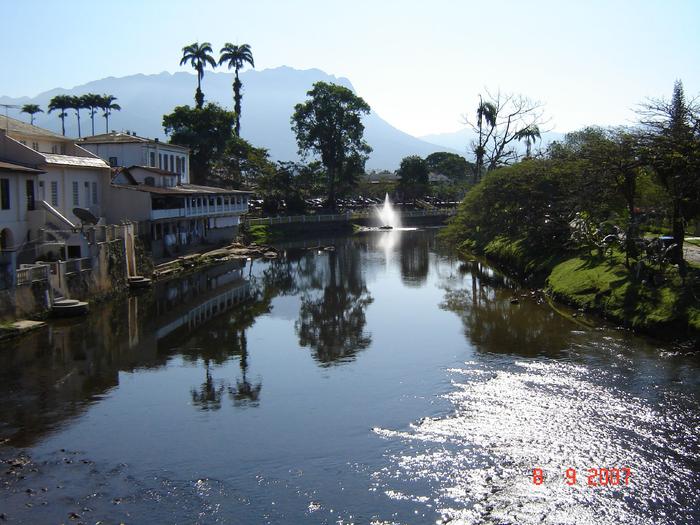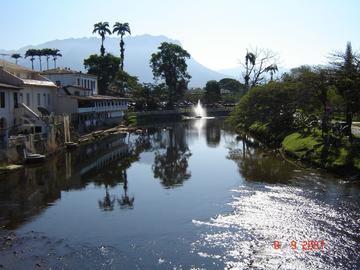Curitiba Travel Picture 1

More information on Morretes in Curitiba Photo by: Luciano Guelfi
Morretes in Curitiba
Curitiba is considered to be one of the best places to live in Brazil. With a metropolitan population of 3.2M people, it is the largest city in Sourthern Brazil. Summer termperatures range from 70F to 90F. The population is primarly Brazilians with European descent, which is more common in Southern Brazil.
This city has many green areas due to extensive urban planning and it is considered to be one of the best examples of urban planning in the world. One of the nicer parks in the city is Barigui Parque, which has so much to offer, including trails, forest areas, grass lands, and a nice large lake.
In 2007, the city was voted 3rd for top "15 Green Cities" in the world, and is generally considered the ecological capital of Brazil. This fact also makes Curitiba a very pleasant place to visit. With plenty of parks, museums, gardens, monuments and squares, one can really enjoy the mild temperate weather of Southern Brazil.
Due to the abundant waves of immigration, Curitiba became a melting pot of different races and cultures, providing nowadays a plethora of international cuisines. Even though European descendants are predominant, there are many other ethnic restaurants in the city, due to the immigration of Japanese citizens in the 20th century, as well as Curitiba's ever-growing tourism. Curitiba is definitely a big metropolis with the cozy feeling of a more provincial town. We highly recommend Curitiba as a must-see travel destination in Southern Brazil!
One of the more famous districts in the area is the Santa Felicidade neighbourhood where the original Italian immigrants moved. With plenty of historic value, mixed in with current generations of Italians, the district is a wonderful place to visit and fairly easy to get it.
The Jardim Botanico or Botanical Gardens is an amazing place to visit and among one of the most popular tourist destinations in the city. The gardens offer a huge park, fountains, trails and other attractions, along with a huge wire and glass structure that houses many botanical specimens.
The video below is a promotional video by the city of Curitiba to help promote tourism, travelers and vacation goers to come visit their beautiful city.
History
Founded in 1693, from a small village pioneer, Curitiba became an important shopping stop with the opening of the road between Sorocaba and Viamão. In 1853, it became the capital of the newly emancipated province of Parana and since then the city, known for its wide streets, maintained a pace of urban growth strengthened by the arrival of a large number of European immigrants throughout the nineteenth century, mostly Germans, Poles, Ukrainians and Italians, which contributed to the cultural diversity that remains today. The city has experienced several urban plans and laws aimed at containing their uncontrolled growth and that led it to become internationally famous for its innovations and care for the urban environment. The largest of these was in transit, which inspired the TransMilenio system, transportation system of Bogotá, Colombia.
Today, the city has a sense of cosmopolitan life, it is considered the capital with better quality of life in Brazil, with a diversified industrial center that gives the rank of fifth largest economy in Brazil, and is considered one of the five best cities to invest in Latin America. Curitiba has also high levels of education. It has the lowest illiteracy rate and best quality in basic education among all capital cities in the country. The MasterCard Index of Emerging Markets 2008, created with the intent to evaluate and compare the performance of cities in different functions that connect markets and commerce around the world, classified Curitiba in 49th place among the cities with greater global influence. Curitiba was also cited in a recent survey published by Forbes magazine as the 3rd largest smartest city in the world. They consider 'smart a city that cares, jointly, to be ecologically sustainable, have quality of life, good infrastructure and economic dynamism.
In the seventeenth century, its main economic activity was mining, allied to agriculture The following cycle, which lasted for the eighteenth and nineteenth centuries, was the 'tropiera activity, derived from livestock. Drovers were cattle drivers that circulated among Viamão in Rio Grande do Sul, and the Fair of Sorocaba, Sao Paulo, driving cattle whose final destination was Minas Gerais. The long road and bad weather made the cowboys take shelter, waiting for the end of the freezing winters in farms located in the "fields of Curitiba. The drovers had traditions such as a ground fire to roast the meat and telling "stories" with their punctuated speech, the mate (yerba mate in hot water in the bowl, because the Indians used it as tererê of cold water), the use of wool ponchos, the pioneering and the formation of villages.
In the late nineteenth century, the cycle of yerba mate and timber growing, two events were quite remarkable: the mass influx of European immigrants and the construction of the Railroad Paranaguá-Curitiba, linking the coast to the First Plateau of Paraná. The immigrants - from Europe and other continents - over the twentieth century, gave new meaning to everyday life in Curitiba. Their ways of being and doing joined the city and are now well-known civic and religious festivities of various races, dance, music, cooking, expressions, and the memory of their ancestors. This is represented in various immigration memorials in public spaces such as municipal parks and woods. The "mythical immigrant labor" (observation of the poet Paul Leminski, who died in the last century) in conjunction with municipal administrations without loss of continuity, eventually creating a planned Curitiba - and an internationally recognized city, in urban management, environment and transportation.
The capital of Paraná, formed a plateau 934 meters above sea level, devoid of landscape landmarks provided by nature, eventually created its own references using science and the human hand. In the twentieth century, under the scene of a planned city, the industry joined forces with the economic profile based on commercial activities and the service sector. The city faced, especially in the 1970s, rapid urbanization, mostly caused by migrations from the countryside, from the substitution of manpower for agricultural machinery. Curitiba is now facing the challenge of a big metropolis, where the urban question is reconsidered from the standpoint of humanism that the city is primarily for those who live in it. Its people, a wonderful melting pot that brought foreigners from all over the world and every corner of Brazil, teaches in the day-to-day the art of meeting and living together. Curitiba is reborn each day with hope and work in the veins, as in the dawn of its pioneers.
- Services
- Tourism Information: +55 (41) 3352-8000
- Afonso Pena International Airport: +55 (41) 3381-1515Bus and Train Station: +55 (41) 3320-3000
- Clínicas Hospital: +55 (41) 3360-1800
- Bank agencies: There are branches from the main banks in the Country.
- CITY FACTS
- Curitiba
- State: Paraná
- Region: South
- AREA CODE: (41)
- Airport: Afonso Pena International Airport (CWB)
- Altitude: 945 m
Area: 434.967 km ²
Per capita green area: 51 m²
Districts: 75
Climate: Subtropical
North-South Extension: 35 km
East-West Extension: 20 km
Time Zone: GMT (UTC-3)
Gentile: Curitibano(a)
Latitude: 25 º 25'48''South
Longitude: 49 ° 16'15''West
Rainfall: 1500 mm / year
Population: 1,851,215 inhabitants (IBGE/2009)
Terrain: Slightly rolling terrain
Average temperature in summer: 21 º C
Average winter temperature: 13 ° C
More Photos of Curitiba Travel Picture 1

